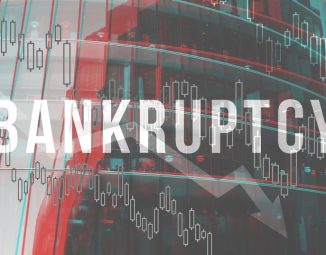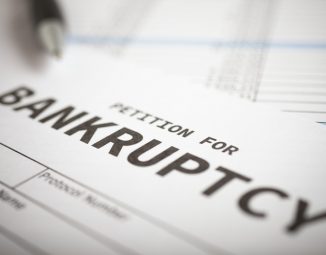Seller Beware! The Ninth Circuit Holds Innocent Sellers Liable for the Return of Misappropriated Company Funds
When a court begins its opinion with the statement that “bad facts make bad law,” you know you are in for a good read. Such was the case with The Ninth Circuit Court of Appeals which recently held that two sellers of real estate and design services were liable for the return of payments alleged to be fraudulent transfers made by the debtor’s principal using misappropriated corporate funds.
The facts of the case are both entertaining and essential to an understanding of this significant ruling. Michael Bello was the sole shareholder, director and president of Walldesign, Inc., a company that installed drywall, acoustical material and plaster in construction projects throughout the Southwest. Walldesign maintained its primary bank account at Comerica Bank. In 2002, Bello opened a different account in Walldesign’s name at Preferred Bank, using Walldesign’s tax identification number and other corporate documentation. However, Bello listed his home for the second account’s address and made his wife — who was not a Walldesign employee — a signatory to the account.
While most of Walldesign’s income and expenses flowed through the primary account, Bello hatched a scheme whereby rebates from the company’s suppliers were, instead, deposited into the secondary account without disclosure to the company’s management. Over a ten-year period, Bello diverted close to $8 million of Walldesign’s funds into the secondary account and used it as his personal piggy bank to support a lavish lifestyle that would be envy of the one percent. Bello used the funds from the secondary account to make payments and purchases of a wine-making vineyard, horseracing stables, casino bills, funding for Bello’s unrelated business pursuits, personal American Express credit card bills, and fees for multiple country clubs. None of the expenditures made from the secondary account benefitted Walldesign.
In 2009, a company controlled by Bello known as RU Investments purchased real property in St. Helena, California from Donald Buresh and Sharen Phillips (the “Bureshes”) for $220,000. The Bureshes had no prior or subsequent relationship with Bello, Walldesign or RU Investments, and the property was sold at arm’s length and for fair value. Bello paid for the property with checks drawn on secondary account which all bore the name “Walldesign, Incorporated.” Bello used the property to construct a tasting room for his wine vineyard avocation.
Over a number of years and occasions, Bello hired Henry West Design, a small interior design firm, for design and construction-related services on buildings owned by Bello. Henry West Design charged its standard rates and there was no suggestion that the transactions were anything other than arm’s length. In similar fashion, Bello did not personally pay for these services. Instead, using checks drawn on the secondary account bearing the Walldesign name, he paid Henry West Design over $230,000 in total.
Given Bello’s extravagant use of corporate funds, it is perhaps not surprising that Walldesign eventually encountered financial difficulties, leading to the filing of bankruptcy in 2012. A Creditor’s Committee was appointed, which filed nearly one hundred adversary proceedings seeking to avoid and recover, as fraudulent transfers, payments Bello made from the secondary account, including those made to the Bureshes and Henry West Design. In a bankruptcy proceeding, pre-petition payments by the debtor, made while insolvent and for less than reasonably equivalent value, may be recovered by the estate for the benefit of its creditors.
The Bureshes and Henry West Design each responded to the Complaints by filing a motion for partial summary judgment asserting that they were not liable for any fraudulent transfers because they were not “initial transferees” under 11 U.S.C. § 550(a)(1) but, rather, were “subsequent transferees” entitled to the safe harbor under § 550(b)(1) of the Bankruptcy Code. When the avoidability of a fraudulent transfer has been established, a trustee or creditor’s committee prosecuting such claim may recover the property, or the value thereof, from (i) the initial transferee of the transfer or the entity for whose benefit the transfer was made or (ii) a subsequent transferee of such initial transferee. 11 U.S.C. § 550(a). However, the statute creates a safe harbor that precludes recovery against a subsequent transferee who takes for value and without knowledge of the voidability of the transfer. The bankruptcy court concluded that the defendants were such subsequent transferees and dismissed the respective Complaints. On appeal, the district court reversed, finding the Bureshes and Henry West Design strictly liable to the Committee because they qualified as initial transferees under § 550(a)(1).
The appeal to the Ninth Circuit focused on the critical distinction between an initial and subsequent transferee. The Bankruptcy Code does not provide a definition of an “initial transferee” under § 550. The Ninth Circuit observed that “transferee” in the context of the statute must mean something other than a mere possessor, holder or agent. To treat anyone who merely touches the money as a transferee would lead to absurd results and unnecessary analytical steps. In the absence of a statutory definition, the Ninth Circuit concluded that the dominion test was the appropriate standard to determine an initial transferee and rejected the defendants’ urging for the application of the control test. The dominion test is satisfied when the recipient of funds has legal title to them and has authority to use the funds as he sees fit. The more lenient control test calls for viewing the transaction as a whole to determine who truly has control of the money.
The Ninth Circuit identified three reasons supporting the application of the dominion test for determining the initial transferee of a corporate misappropriation.
First, the Court concluded that the terms of the statute, with its reference to the transfer of property, compel that result. A principal does not establish dominion by merely misdirecting company funds directly to a third party for personal gain.
Second, the structure of § 550(a)(1) indicates that a principal does not become a an initial transferee simply by exerting control over corporate assets to effect a fraudulent transfer. The party who forces a misallocation is almost always the beneficiary of the transfer and is subject to strict liability. Yet, Congress intended to make the initial transferees also liable. The distinction in the statute between beneficiaries of the transfer and initial transferees suggests that the two are envisioned to be separate parties to a fraudulent transfer.
Third, the underlying policy objectives of § 550 are served by defining “initial transferees” as those who have legal control over the funds as opposed to mere de facto control. Deeming every agent or principal of the debtor to be an initial transferee when corporate property is misallocated in his or her representative capacity would deprive the trustee of a potential source of recovery for creditors. Congress likely realized that recovery from embezzling principals would be difficult and, thus, intended to make the first recipients of the funds strictly liable to the estate. Congress intended recovery from all parties under § 550 — good guys and bad guys alike — since collecting from the embezzling principal alone would prove difficult and unlikely to result in significant recoveries for creditors.
Having arrived at the applicable standard to determine an initial transferee, the Ninth Circuit turned to the facts of the case. Bello used corporate documentation and consents to open the secondary account in the company’s name. It was undisputed that the secondary account belonged to Walldesign and not to Bello. Bello misdirected the Walldesign funds directly from this account to third parties such as the Bureshes and Henry West Design using checks emblazoned with the name “Walldesign Incorporated.” Despite the concealment of the secondary account and Bello’s use of it for personal gain, Walldesign remained the legal owner of the account. Accordingly, the Ninth Circuit concluded that the payments were made directly from the company to the Bureshes and Henry West Design and, thus, found the defendants to be the initial transferees.
The Ninth Circuit suggested that a different judicial outcome would likely result if Bello established legal control and dominion by first directing a transfer into his personal bank account and then making a payment to a creditor. But such was not the case here as a principal does not establish dominion simply by directing corporate funds directly from the company to a third party.
The interests of public policy would be furthered by deeming the Bureshes and Henry West Design as the initial transferees rather than secondary transferees with potential safe harbor protections. It would undermine § 550 to declare Bello the initial transferee since it would be unreasonable to assume that an insider who misappropriates company funds has the incentive to monitor the company for fraud. The Ninth Circuit found it fair to view the Bureshes and Henry West Design as the initial transferees since they received the funds directly from the debtor and had the opportunity to monitor the transaction for fraud. That the defendants received checks from Bello bearing the name “Walldesign Incorporated” provided at least some indication that something was amiss.
The majority opinion of the Ninth Circuit, holding the Bureshes and Henry West Design strictly liable as initial transferees of the payments, prompted an impassioned dissent. Bankruptcy courts are courts of equity and the dissent found nothing equitable about the majority’s decision. The defendants’ dealings with Bello were legitimate, arm’s-length transactions and now they faced the prospects of repaying hundreds of thousands of dollars to the estate. Further, the dissent disagreed that under the dominion test that the Bureshes and Henry West Design were the initial transferees of the payments and viewed the secondary account as being co-opted and not belonging to Walldesign. Had Bello paid the defendants directly from the Debtor’s primary account, the dissent acknowledged that the transactions would have unquestionably occurred in one step. However, the dissent viewed the creation of the second account as Bello’s personal account and that it should not be imputed to the company. In the eyes of the dissent, while Bello possessed authority to open bank accounts on behalf of the company, the authority did not extend to opening secret accounts solely for his personal benefit at the company’s expense. Because Bello was acting adversely to the company in opening the sham account, he did so in his personal capacity and not as an officer of the company. The dissent observed that businesses often pay for the personal expenses of their executives and did not see anything inherently suspicious about Bello using checks of a closely-held corporation to pay for his personal expenditures.
How can an innocent seller of goods or services protect itself from the crushing fate that befell the Bureshes and Henry West Design? Most individuals or small proprietorships lack the resources to survive the disgorgement of the six-figure sums sought by the Trustee. The Ninth Circuit places a large, and perhaps unfair, burden on sellers of goods and services, like the Bureshes and Henry West Design, to monitor the transaction for impropriety. The use by Bello of a check bearing the name of Walldesign should have, according to the reasoning of the Ninth Circuit, aroused the suspicions of the sellers. That puts sellers, however, in the uncomfortable position of questioning the integrity of their customers or demanding corporate consents to confirm that the company has authorized and is receiving value for the purchase. Such inquiry would likely be met with resistance for simple reasons of inconvenience rather than subterfuge. In most arm’s length transactions, the seller simply does not know that much about the business nature and activity of their customers. Thus, a seller in a transaction with an individual who is presented with payment of a check drawn on a corporate account is faced with the difficult choice of questioning and potentially alienating his customer or accepting payment without inquiry and hoping for the best. Let the seller beware!





